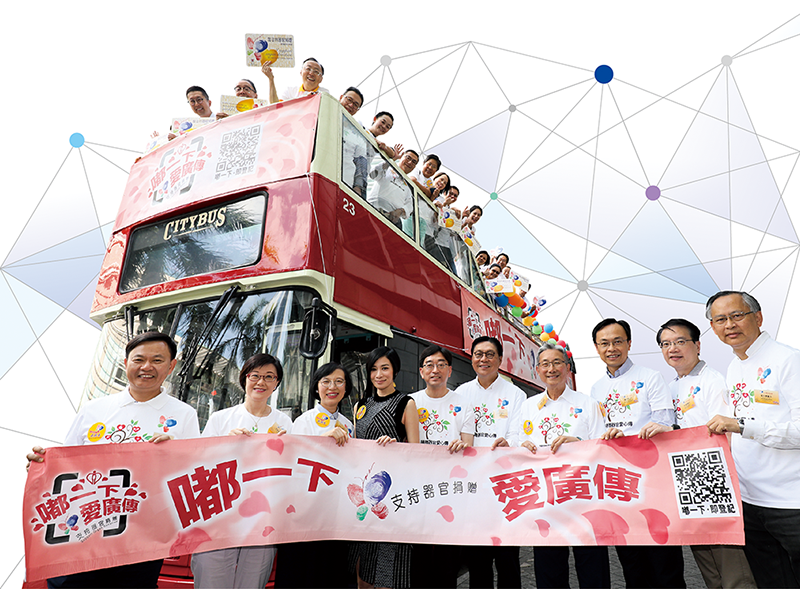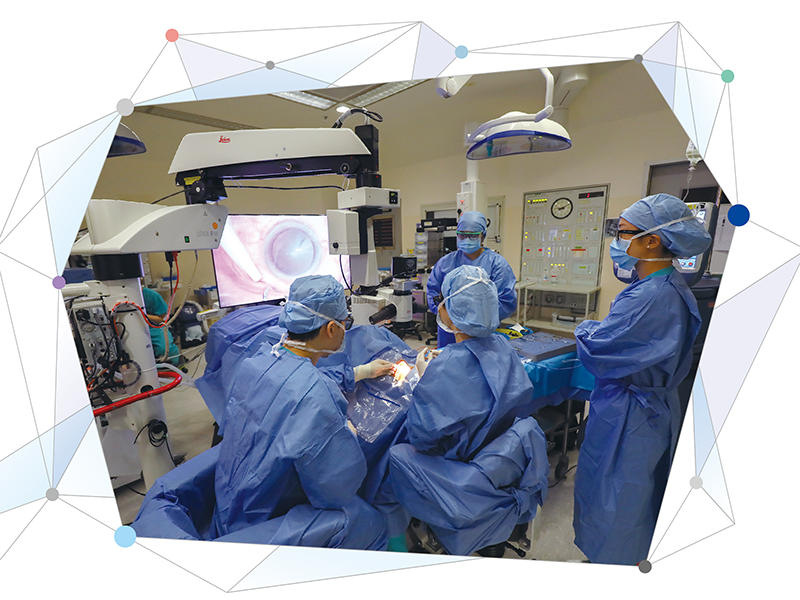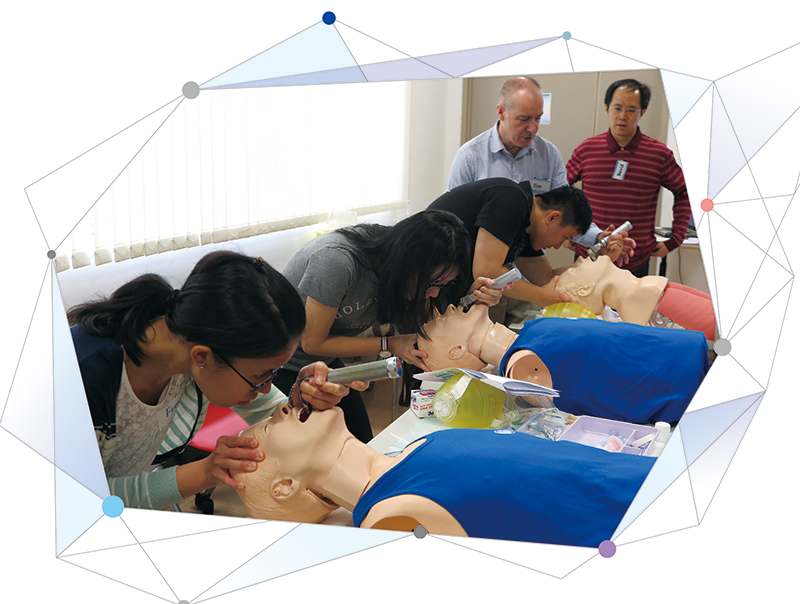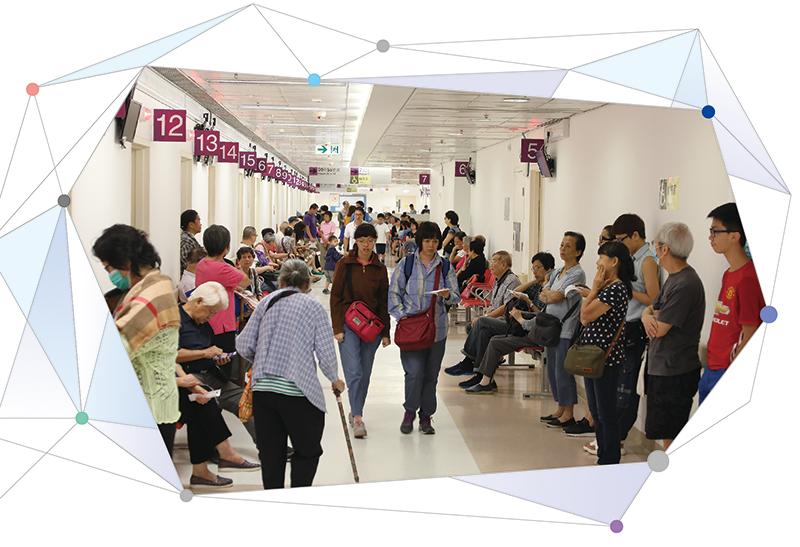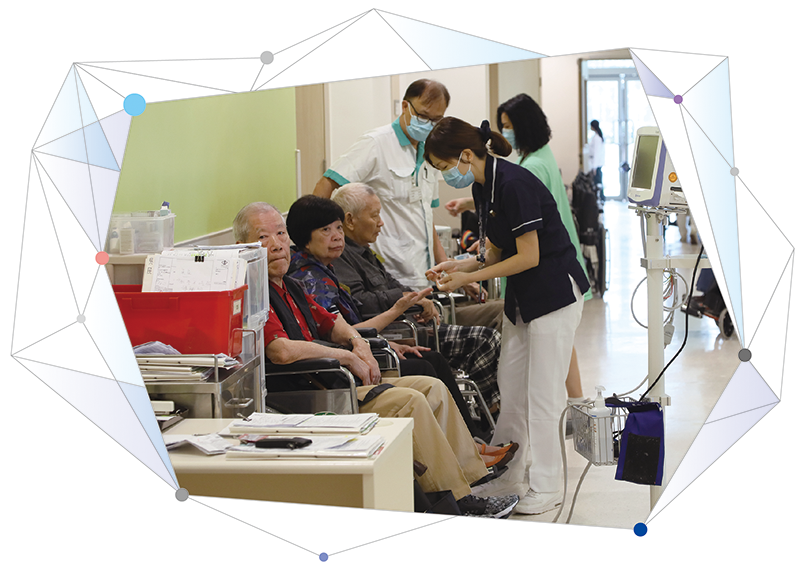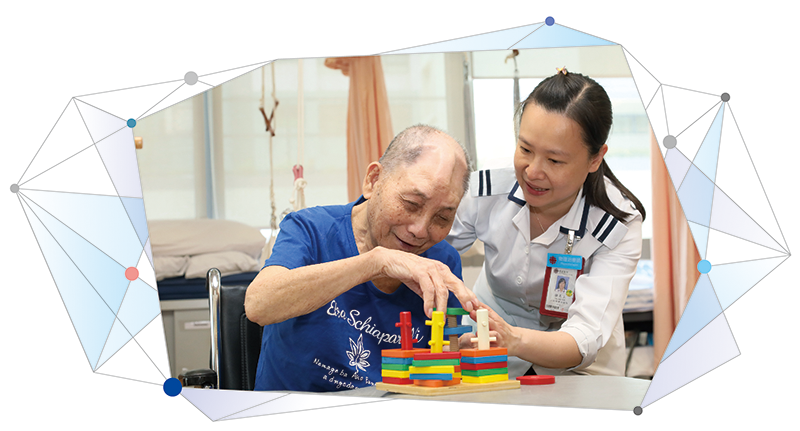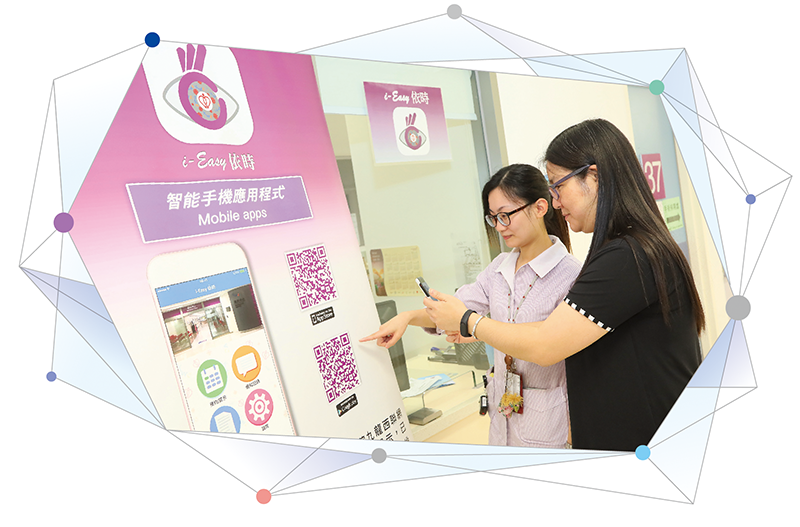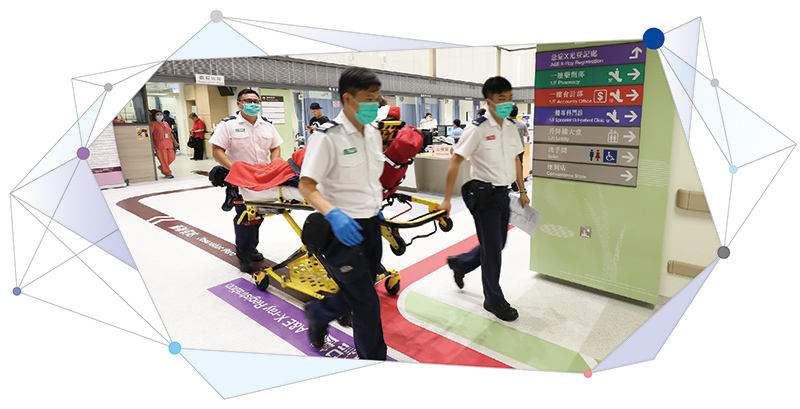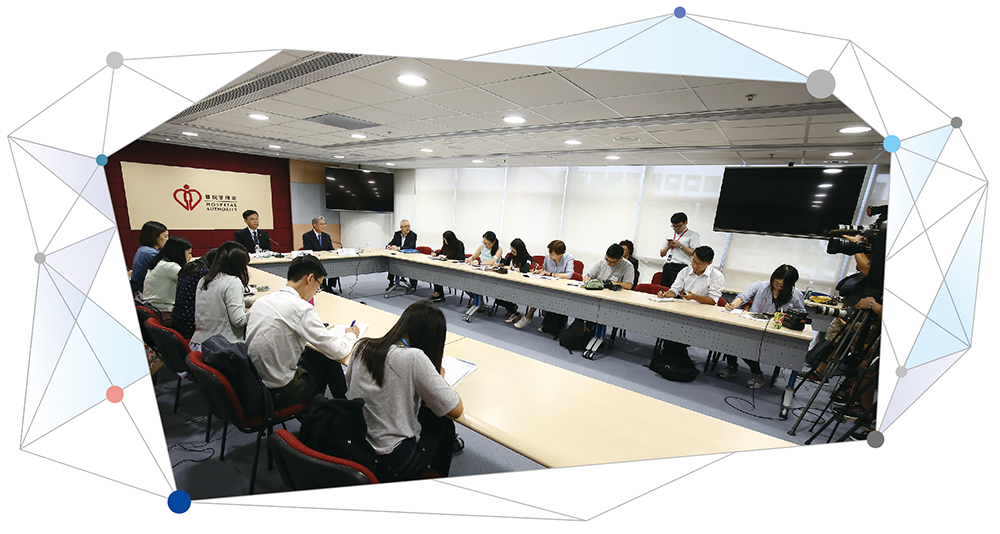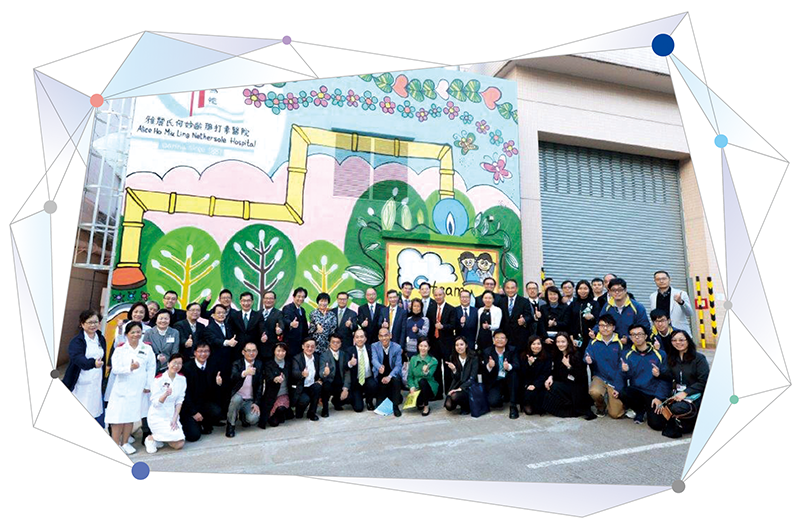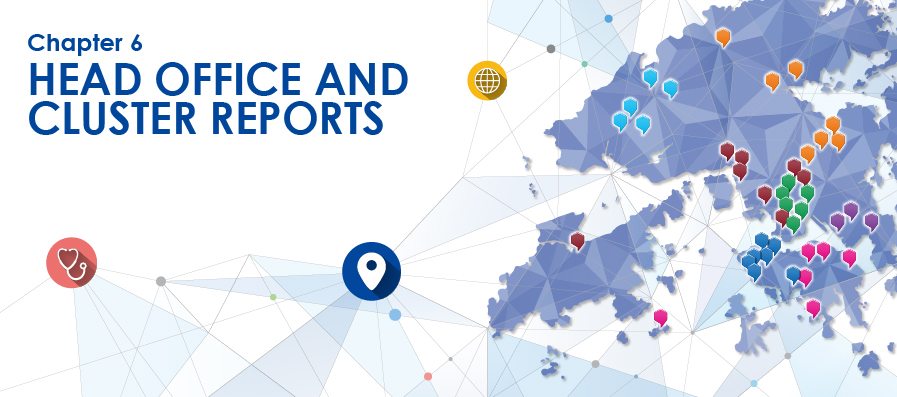
The Hospital Authority (HA) provides public healthcare services to the people of Hong Kong through the Head Office and seven hospital clusters.
Head Office and Cluster Reports present an overview of the performance of HA Head Office and Clusters under six corporate strategic intents and also achievements in contributing to a friendly environment.
Head Office Report
HA Head Office (HAHO) aligns corporate values and directions. It plays a strategic role in leading corporate development and supporting hospital clusters through interactive collaboration of seven divisions, namely Cluster Services, Corporate Services, Finance, Human Resources, Information Technology and Health Informatics, Quality & Safety, and Strategy & Planning. HAHO initiated around 100 programme targets in 2016-17 under six strategic intents outlined in the HA Annual Plan.
Strategic intent:
Allay staff shortage and high turnover
A series of measures were unveiled to alleviate manpower shortfall and high turnover, including recruitment of more than 460 doctors, 1,750 nurses and 580 allied health professionals. As at March 2017, there were 15 non-local doctors working as Service Residents under Limited Registration in HA.
To encourage and retain well-qualified staff, additional promotion opportunities were offered under the Additional Associate Consultant Promotion Mechanism. Besides, an annual progression exercise introduced in 2015-16 was continued to retain Patient Care Assistants of inpatient services on 24 hours shift.
HA strives to strengthen its workforce for service provision. In view of the lack of local training for podiatrists, overseas scholarship was offered to eight selected podiatrist students to study a three-year degree course in the United Kingdom. Midwifery training programmes were provided in an attempt to address growing demand for maternity services in public hospitals.
With the $300 million Government designated training fund in place, various training programmes were rolled out in 2016-17 for both clinical and non-clinical staff for supporting service development, professional development and operational needs. To enhance management capabilities of senior clinical leaders and executives, more e-modules of Healthcare Service Training Management were released. Training programmes on people skills and team leadership, as well as vocational training to strengthen technical competencies of patient care assistants were also provided.
With an aim to promote career development, preceptorship programmes were provided to newly recruited nurse graduates. There were overseas training scholarships for doctors, nurses, allied health staff and pharmacists, and training subsidies were offered to healthcare professionals. Territory-wide simulation training programmes were developed for doctors and nurses in major specialties to enhance career development opportunities and professional capabilities. Mediation skills training was also organised for frontline staff to enhance their competency in patient engagement and conflict resolution.
Strategic intent:
Better manage growing service demand
As recommended by the Steering Committee on the Review of HA, re-delineation of cluster boundary between Kowloon Central Cluster (KCC) and Kowloon West Cluster (KWC) took place in phases with a view to further enhancing vertical integration of services, strengthen the continuity of care for patients and reduce cross-cluster consultations. Three hospitals namely Kwong Wah Hospital, Our Lady of Maryknoll Hospital and TWGHs Wong Tai Sin Hospital, and the services units were regrouped from KWC to KCC with effect from 1 December 2016. Refining the cluster boundary will promote a better balance in the service demand among the three Kowloon clusters. Reorganisation of clinical services will proceed by phases after 1 April 2017 upon readiness of supporting functions and infrastructure.
Task Force on Winter Surge regularly reviews the strategy and response plan for winter surge, and coordinates step-up measures in order to cope with the anticipated increase in service demand. In 2016-17, around 18,000 additional service quotas of GOPCs were provided during the winter surge period. Around 5,000 service quotas of GOPCs were further added during Christmas, Chinese New Year and Easter holidays. Appeals were also made to the public for appropriate use of Accident and Emergency (A&E) services.
Tremendous effort has been made by HA to reduce waiting time in various patient services. At A&E Departments, the A&E Department Support Session Programme continued in 17 A&E Departments of HA to handle Triage IV (semi-urgent) and V (non-urgent) cases. The fifth joint replacement centre in HA was set up in Hong Kong West Cluster to provide additional surgeries to alleviate the waiting time for joint replacement surgery.
Services of high demand on life threatening diseases were strengthened. Grantham Hospital and TWGHs Wong Tai Sin Hospital provided designated beds to offer centralised care for chronic ventilator-dependent patients. Multi-disciplinary care was provided for additional Human Immunodeficiency Virus (HIV) new cases, and Highly Active Antiretroviral Therapy (HAART) was offered to eligible patients in Queen Elizabeth Hospital and Princess Margaret Hospital. Support to Hospital Authority Infectious Disease Centre was strengthened by recruiting additional medical manpower in Queen Elizabeth Hospital and Princess Margaret Hospital to provide rapid response at the first stage of the emerging major outbreaks of infectious diseases in Hong Kong.
The Transient Ischaemic Attack (TIA) service in New Territories West Cluster (NTWC) was reinforced together with the preparation for further enhancement of thrombolysis service. Patients can thus receive early treatment and proper diagnosis, reducing disability and likelihood of future stroke events. For renal services, the provision of haemodialysis (HD) service was expanded with additional hospitals HD, nocturnal home HD, and automated peritoneal dialysis added, while the HD Public-Private Partnership (PPP) programme continued.
Apart from HD PPP, the PPP programmes of cataract surgeries, primary care service and radiological investigation service continued. On top of the three piloting districts of Kwun Tong, Wong Tai Sin and Tuen Mun, the GOPC PPP programme was rolled out to nine more districts (Eastern, Southern, Wan Chai, Kowloon City, Sham Shui Po, Kwai Tsing, Sai Kung, Sha Tin and Yuen Long), offering convenience for patients seeking primary healthcare services and relieving the pressure on public general outpatient service. Provision of infirmary care services by an non-governmental organisation commissioned via PPP commenced at Wong Chuk Hang Hospital in September 2016, with full operation from December 2016 onwards.

Strategic intent:
Ensure service quality and safety
HA continued to adopt modern technology and new treatment options, including the use of new biomarkers to improve the accuracy of prostate cancer detection. We also built up service capacity of In-vitro Fertilisation (IVF) by adding IVF cycles in Queen Mary Hospital. For prevention of hepatitis B reactivation for cancer patients, additional hepatitis B virus DNA tests were provided for target patients.
The scope of HA Drug Formulary was widened to cover more drugs with accumulated scientific evidence on clinical efficacy. Two classes of self-financed drugs for secondary stroke management and osteoporosis treatment were repositioned as special drugs in the HA Drug Formulary, while the clinical applications of three special drug classes were expanded for management of diabetes mellitus, secondary prevention of osteoporotic fracture and breast cancer treatment. As a proactive measure to enhance the transparency on the Drug Formulary, the HA Drug Formulary Management Manual (“the Manual”) was published, with particular emphasis on the governance, principles, operating procedures, consultation and engagement of stakeholders in HA’s drug formulary management. HA promulgated the Manual to its stakeholders to enhance their understanding and confidence in HA’s drug formulary management system.
A breastfeeding support team was established in Pamela Youde Nethersole Eastern Hospital and Tuen Mun Hospital respectively in support of HA’s policy of promoting breastfeeding for newborn babies in HA hospitals. Other initiatives included enhancement of the custom print informed consent system to support workflow of both surgeons and anaesthetists, and recruitment of additional manpower to assist in planning and implementation of comparative audit as prioritised by Coordinating Committees (Neurosurgery) to monitor the outcomes of neurosurgery.
Through the funding support from the Government to the Capital Block Vote as well as the Designated Fund of HA, medical equipment items were installed as additions or replacements in public hospitals at the total cost of approximately $782 million in the year.
New Key Performance Indicators (KPIs) reflecting capacity-demand gap and service efficiency have been developed for key pressure areas, including specialist outpatient services, operating theatre (OT) services and access block monitoring. The KPIs on specialist outpatient services and OT utilisation provided direction for capacity building and resource allocation. The access block indicator could facilitate hospitals to review their situation and take actions in a timely manner.
Strategic intent:
Enhance partnership with patients and community
HA strives to enhance community support for children with special-care needs in special schools. Case managers were recruited in Caritas Medical Centre, Kwong Wah Hospital, Pamela Youde Nethersole Eastern Hospital and Queen Elizabeth Hospital to provide integrated care.
To promote chronic disease management, the implementation of the Patient Empowerment Programme with non-governmental organisations continued to provide patients with disease specific education and self-care skills.
Positive results were revealed in the Report of Patient Experience and Satisfaction Survey on Inpatient Service (the Survey) last year. With the findings of the Survey, HA can better understand the needs and expectations of patients for continuous quality improvement.
To foster close partnership with patients and the community, a planning workshop on Patient Resources Centre (PRC) services was conducted with key stakeholders in 2016-17 to formulate strategies and priority actions on patient empowerment and volunteer service development. We also launched nine pilot collaborative projects involving patient groups, clinical teams and PRCs in hospitals to enhance peer support and disease management for chronic disease patients. In addition, the 4th batch of Patient Partnership in Action (PPIA) training programme was conducted in the year to train up patient leaders. The Smart Patient Website has also been enhanced with the launch of a new webpage and eight languages for the ethnic minorities.
To strengthen interaction and reach out to different sectors of the community, web-based platforms and social media are adopted for information dissemination. In addition to the corporate website, HA Facebook page and YouTube Channel published a total of more than 560 posts and 30 videos in 2016-17 respectively.
HA has leveraged on advanced technology to strengthen communication with the public and improve services for patients. With push notification function in HA corporate mobile application HA Touch, users will be able to stay up-to-date with important news on public healthcare services and health activities. In addition to gynaecology, the coverage of BookHA was further extended to cardiothoracic surgery, ear, nose and throat, eye, medicine, neurosurgery, orthopaedics and traumatology, and surgery, bringing greater convenience to the public in making specialist outpatient clinic (SOPC) new case appointments. Another mobile app HApi Journey was launched in February 2017, providing useful information for pregnant women.
A proactive approach is adopted to maintain rapport and communicate with the media and community stakeholders to keep them abreast of the latest development in HA policies and services. During the year, about 180 media activities were organised, 420 press releases were issued and 340 articles were contributed to various media platforms. About 2,570 media enquiries and 220 community enquiries were handled. Furthermore, more than 20 meetings with Legislative Councillors and community stakeholders were arranged or attended, while more than 100 District Council meetings and related activities were handled.
Strategic intent:
Ensure adequate resources for meeting service needs
The Government continued its commitment to public healthcare through providing subvention to HA, which reached $53 billion in 2016-17. HA would continue to adopt prudent financial measures to ensure public resources are used properly and efficiently.
Through HA’s annual planning exercise, resource requirement of individual clusters was identified and considered against the total amount of resources available to HA, so as to maintain existing levels of services, to train and build up Hong Kong’s future healthcare workforce by recruiting new graduates, and to provide pragmatic service growth in meeting the pressing demand for public hospital services. To facilitate the delivery of value-for-money services, HA regularly monitors a set of performance indicators covering service output, performance and resources.
In 2016-17, HA recruited additional manpower to sustain the level of service provision to cater the rising healthcare needs of the community. Given no additional recurrent Government subvention in 2016-17 under the Government-wide expenditure control measures, HA had to operate under a deficit budget in 2016-17 and recorded an operating deficit of $1.5 billion, which was funded by HA’s one-off revenue reserve as an interim measure. Since service provision will bring recurrent financial implication, the deployment of one-off savings to maintain daily operation will not be sustainable in long term. HA will continue to perform medium-term financial projection to assess possible financial outlooks under different scenarios and reflect its financial position and funding needs to the Government.
With an aim to minimise the non-clinical duties of clinical staff and to better control and monitor ward stock of non-drugs supplies, the enhanced central coordinated refill service has been rolled out in hospitals by phases since 2013-14. Full implementation was achieved after the final phase of implementation in 16 hospitals of five clusters in 2016-17.
HA continued to embrace technology-based solutions to deliver efficient healthcare services. 12 new or enhanced modules under Clinical Management System III Phase Two project in 2016-17 were completed. Nine clinical mobile apps were developed to help clinical staff to provide better bedside care. The deployment of advanced digital imaging technology in operating theatres of major hospitals was continued to improve surgical services. With the implementation of Inpatient Medication Order Entry system in five hospitals in 2016-17 including Alice Ho Miu Ling Nethersole Hospital, Caritas Medical Centre, North District Hospital, Pamela Youde Nethersole Eastern Hospital and Pok Oi Hospital, the risk of prescription errors was further reduced.
IT Infrastructure and systems were implemented to support service operation of new hospitals and hospital blocks, including Tin Shui Wai Hospital and relocation of Yaumatei Specialist Outpatient Clinic to Queen Elizabeth Hospital.
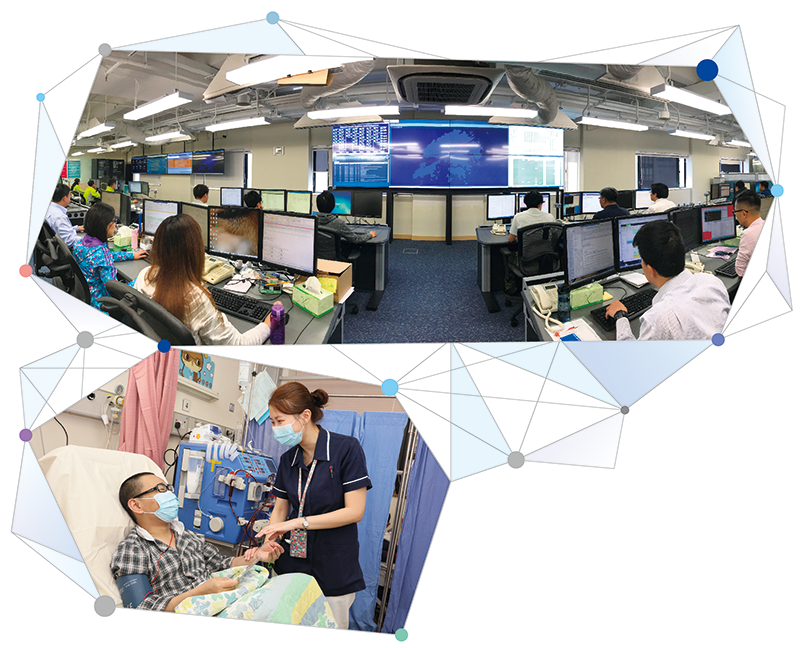
The Enterprise Resource Planning Asset Management System for both IT assets and medical equipment was successfully implemented. A number of enhancements were planned to streamline operational workflows.
Through the adoption of automation tools, HA enhanced its level of quality assurance controls and internal IT systems development processes to minimise code errors and reduce system vulnerabilities. With the ongoing project-based review and annual enterprise IT risk management processes, IT system availability and accuracy of data will continue to be improved.
HA attaches great importance to patient data privacy. Sustained effort were made to strengthen privacy controls, identify emerging cybersecurity risks, and respond to incidents in a timely manner. In-house developed training programmes on privacy and IT security were made available to all staff to enrich their knowledge in these areas. These programmes will be updated regularly. Hospital privacy compliance checks, forums and inspections additionally contributed to the heightening of staff awareness in patient privacy protection. HA continued to participate in the Privacy Management Programme led by the Privacy Commissioner for Personal Data, adopting the best practices, technical infrastructure and operational processes throughout its clusters, hospitals and clinics.
HA played dual roles in the Government’s Electronic Health Record (eHR) programme – both as a technical agency to assist the Food and Health Bureau in the development of Electronic Health Record Sharing System (eHRSS), and as one of the major healthcare providers (HCPs) to share patients’ health data through the eHRSS. The first stage of eHRSS has been operating smoothly since its launch in March 2016. Separately, HA also continued to provide technical services to the Department of Health for the Elderly Healthcare Voucher Scheme, Vaccination Schemes, Primary Care Directory System, Communicable Disease Information System, Laboratory Information System and Colorectal Cancer Screening Programme System and all systems have been operating smoothly.
HA collaborated with the tripartite Chinese Medicine Centres for Training and Research to implement the disease-based Integrated Chinese-Western Medicine (ICWM) Pilot Programme for eligible HA inpatients in designated hospitals in two phases.
Strategic Intent:
Enhance corporate governance
Sustained efforts were made by the HA Board to implement a spectrum of enhanced practices to ensure accountability and stewardship of HA’s resources and management of services. The HA Board is committed to good corporate governance and will continue to reinforce its leading and managing role on HA, as recommended in the HA Review. The Board has set out overarching policies to guide and provide scope for the Executive Management who were responsible for implementing the approved plans and managing HA’s operation. The roles of functional committees in long-term strategy planning and risk management were strengthened, as set out in their revised terms of reference. The Board has adopted an integrated approach in risk management to ensure the integrity of different organisational functions and avoid potential risks from happening. In 2016-17, familiarisation programme in the form of sharing sessions and corporate visits continued, keeping members abreast of the knowledge and skills applicable to the public sector operations.
The Manual on the Operation of Hospital Governing Committees (HGCs) encompassing various corporate governance policies and practices adopted by the Board and HGCs over the years, provides guidance to HGC members in discharging their responsibilities. Much effort has been made to enhance the communication between the Board and HGCs, as well as between HGCs and the management at cluster and hospital level and frontline staff, which in turn facilitated the effective management of hospitals under HA’s overall policies and strategies.
Contributing to a green environment
HA is committed to the health of the community, and contributing to a sustainable living environment is one of the keys.
A wide range of energy efficient features and renewable energy technologies were applied to air-conditioning, lighting, steam and hot water installations in new hospital construction projects as well as improvement works of existing hospitals. HA continued to replace aged air-cooled air-conditioning chillers in various HA venues with energy-efficient oil-free air-cooled chillers in 2016-17.
In November 2016, a Combined Heat and Power plant commenced operation in Alice Ho Miu Ling Nethersole Hospital as the first hospital in Hong Kong in adopting such system. Incorporating the concept of practising waste-to-energy, the system generates electricity from landfill gas, and at the same time supplies steam and hot water for hospital by reclaiming waste heat from the generator’s cooling and exhaust system.
The application of energy efficient technologies, together with good operation and housekeeping practices, helps HA offset the rising trend of energy consumption due to increasing hospital activities. Hospitals and institutions continued to proactively participate in waste reduction and recycling programmes organised by different organisations in support of environmental protection. Besides, food waste reduction programmes, such as promotion of waste reduction at source and adoption of low carbon menu, continued in hospitals.

